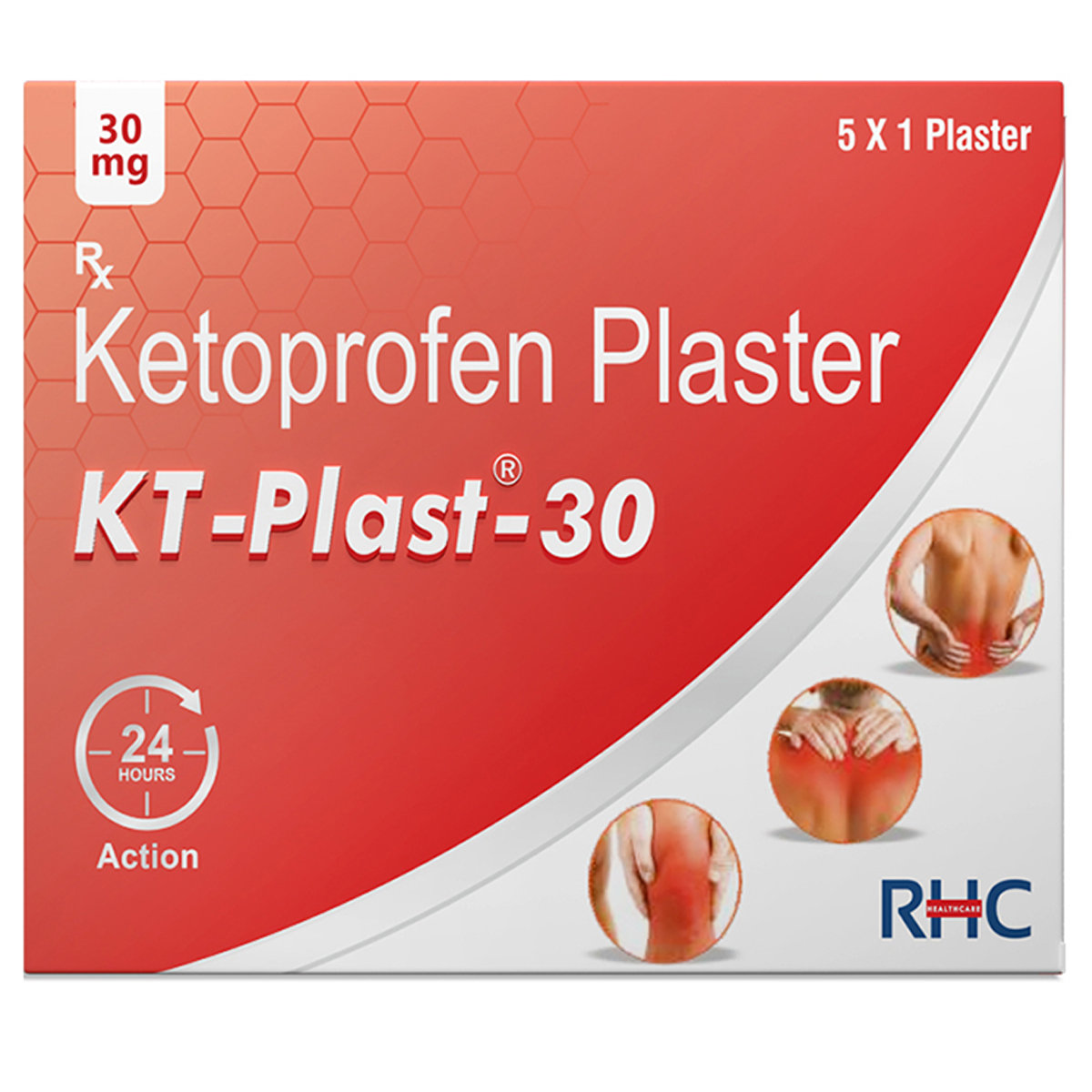K-Plast Transdermal Patches 7's

MRP ₹196.5
(Inclusive of all Taxes)
₹29.5 Cashback (15%)
K-Plast Transdermal Patches is used to provide symptomatic relief of pain in conditions like soft tissue injuries, including sprains, strains, sports injuries, swelling, backache, muscle-tendonitis, and rheumatic pain. It contains ketoprofen, which works by blocking the action of the cyclo-oxygenase (COX) enzyme in the body, which is involved in producing certain chemical substances, such as prostaglandins, that cause pain and swelling. Thereby, it helps relieve pain and swelling.
Know Your Delivery Time
Provide Delivery Location

Secure Payment

India's Most Trusted Pharmacy

Genuine Products
Composition :
Manufacturer/Marketer :
Consume Type :
Return Policy :
Expires on or after :
About K-Plast Transdermal Patches
K-Plast Transdermal Patches belongs to a class of nonsteroidal anti-inflammatory drugs (NSAIDS) used to provide symptomatic relief of pain in conditions like soft tissue injuries, including sprains, strains, sports injuries, swelling, backache, muscle-tendonitis and rheumatic pain. Pain is an unpleasant sensation caused by an injury or illness. Pain may be acute (short-term) or chronic (long-term).
K-Plast Transdermal Patches contains ketoprofen, which works by blocking the action of cyclo-oxygenase (COX) enzyme in the body involved in producing certain chemical substances, such as prostaglandins, that cause pain and swelling. Thereby, it helps relieve pain and swelling.
Use K-Plast Transdermal Patches as recommended. Sometimes, you may experience application site reactions, itching, rash, blisters and dry skin. Most of these side effects of K-Plast Transdermal Patches do not require medical attention and typically resolve on their own over time. However, if the side effects worsen or persist, please consult your doctor.
Before using K-Plast Transdermal Patches, inform your doctor if you have any other medical conditions, sensitivities, and about all medications you are using. Consult your doctor if you are pregnant, planning to become pregnant, or breastfeeding. Avoid contact of K-Plast Transdermal Patches with mucous membranes such as eyes, nose, or mouth. If contact occurs, rinse the affected area immediately with water.
Uses of K-Plast Transdermal Patches
K-Plast Transdermal Patches is used in the treatment of pain and inflammation. The detailed uses of K-Plast Transdermal Patches are as follows:
- Management of osteoarthritis and rheumatoid arthritis: K-Plast Transdermal Patches relieves joint pain, swelling, and stiffness caused by chronic inflammatory conditions.
- Treatment of soft tissue injuries: K-Plast Transdermal Patches effectively manages pain and inflammation caused by muscle, ligament, or tendon injuries.
- Relief of acute strains: K-Plast Transdermal Patches provides relief from pain and swelling caused by sudden muscle overstretching or tearing.
- Management of sprains: K-Plast Transdermal Patches can help treat ligament injuries by lowering inflammation and speeding up healing.
- Control of inflammation: K-Plast Transdermal Patches reduces inflammation caused by injury or chronic conditions, improving mobility and comfort.

Have a query?
Directions for Use
- Transdermal patch: Apply the patch to a clean and dry skin area as your doctor advises.
- Gel: It is only for external use. Take a small amount of the medicine on the fingertip and apply it as a thin layer on the clean and dry chest area as prescribed by your doctor. Avoid contact with this medicine on your nose or eyes. In the event of accidental contact with these areas, rinse thoroughly with water.
Medicinal Benefits
K-Plast Transdermal Patches contains ketoprofen, a pain reliever used to relieve acute moderate to severe pain in various medical conditions such as soft tissue injuries, including sprains, strains, sports injuries, swelling, backache, muscle-tendonitis and rheumatic pain. It works by blocking the action of the cyclo-oxygenase (COX) enzyme in the body, which is involved in producing certain chemical substances, such as prostaglandins, that cause pain and swelling. Thereby, it helps relieve pain and swelling.
How K-Plast Transdermal Patches Works
Storage
- Drink warm fluids such as warm water with honey, broth, soup or herbal tea to soothe sore throat.
- Gargle with warm salt water.
- Suck on lozenges to increase the production of saliva and soothe your throat.
- Use a humidifier to soothe sore throat as it adds moisture to the air and makes breathing easier.
- Handle your eyes with care and try not to rub them, as this can make the irritation worse.
- If you wear contact lenses, take them out to let your eyes have a rest.
- Use a cool, wet cloth on the eye that's bothering you to help reduce swelling and discomfort.
- Stay away from things that can bother your eyes, such as smoke, dust, and chemicals.
- Get lots of rest and don't push yourself too hard, as this can put extra stress on your eyes.
- If your eyes don't start feeling better or get worse, make an appointment with an eye doctor to get a proper check-up and some advice on how to make your eyes feel better.
What if I have taken an overdose of K-Plast Transdermal Patches
Drug Warnings
Before using K-Plast Transdermal Patches, inform about all your sensitivities or allergic conditions and about all medications you use. In addition, let your doctor know if you have asthma, congestive heart failure, GI disorders, dermatitis (rash), renal toxicities and thrombosis (cerebrovascular Insufficiency) before using K-Plast Transdermal Patches. And also, inform your doctor if you are pregnant, suspect you are pregnant, plan to have a baby, or are breastfeeding. If you become pregnant while receiving K-Plast Transdermal Patches therapy, inform your doctor. K-Plast Transdermal Patches is not recommended for children as safety and effectiveness have not been established.
Drug-Drug Interactions
Drug-Drug Interactions
Login/Sign Up
Coadministration of ketorolac together with K-Plast Transdermal Patches may increase the risk of side effects in the gastrointestinal tract such as inflammation, bleeding and ulcers.
How to manage the interaction:
Taking Ketorolac with K-Plast Transdermal Patches is not recommended, but it can be taken together if prescribed by a doctor. However, consult your doctor if you experience any unusual bleeding, dizziness, lightheadedness, red or black, tarry stools, coughing up or vomiting fresh or dried blood that looks like coffee grounds, severe headache, and weakness. Do not discontinue any medications without consulting a doctor.
Taking Flurbiprofen with K-Plast Transdermal Patches can increase the risk of side effects.
How to manage the interaction:
Co-administration of Flurbiprofen with K-Plast Transdermal Patches can possibly result in an interaction, but it can be taken if your doctor has advised it. If you're having any of these symptoms like stomach pain, bleeding, or feeling dizzy, it's important to contact your doctor right away. They may be able to recommend other options that won't cause these problems. Remember to reach out to your doctor if you experience any unusual symptoms. Do not discontinue any medications without first consulting your doctor.
Taking Dabigatran etexilate with K-Plast Transdermal Patches can increase the risk of bleeding leading to serious blood loss.
How to manage the interaction:
Taking Dabigatran etexilate with K-Plast Transdermal Patches together can possibly result in an interaction, but it can be taken if your doctor has advised it. However, if you experience unusual bleeding or bruising, dizziness, lightheadedness, red or black, tarry stools, coughing up or vomiting fresh or dried blood that looks like coffee grounds, severe headache, and weakness, consult the doctor. Do not stop using any medications without a doctor's advice.
Co-administration of Meloxicam with K-Plast Transdermal Patches can increase the risk of side effects.
How to manage the interaction:
Although taking Meloxicam and K-Plast Transdermal Patches together can evidently cause an interaction, it can be taken if a doctor has suggested it. If you're having any of these symptoms like inflammation, bleeding, or stomach problems, unusual bleeding or bruising, dizziness, lightheadedness, red or black, tarry stools, coughing up or vomiting fresh or dried blood that looks like coffee grounds, severe headache, and weakness, consult the doctor. Do not stop using any medications without a doctor's advice.
Co-administration of Ibrutinib with K-Plast Transdermal Patches can increase the risk of bleeding leading to serious blood loss.
How to manage the interaction:
Taking Ibrutinib with K-Plast Transdermal Patches together can result in an interaction, but it can be taken if a doctor has advised it. However, if you experience unusual bleeding or bruising, dizziness, lightheadedness, red or black, tarry stools, coughing up or vomiting fresh or dried blood that looks like coffee grounds, severe headache, and weakness, consult a doctor. Do not stop using any medications without a doctor's advice.
Taking Human immunoglobulin with K-Plast Transdermal Patches, may raise the risk of kidney problems.
How to manage the interaction:
There may be a possibility of interaction between Human immunoglobulin and K-Plast Transdermal Patches, but it can be taken if prescribed by a doctor. However, if you experience nausea, vomiting, loss of appetite, increased or decreased urination, sudden weight gain or loss, fluid retention, swelling, shortness of breath, muscle cramps, tiredness, weakness, dizziness, confusion, or an irregular heart rhythm, consult a doctor. Do not discontinue any medications without consulting a doctor.
Coadministration of Naproxen and K-Plast Transdermal Patches can increase the risk or severity of gastric bleeding, ulceration, and rarely, perforation leading to serious blood loss.
How to manage the interaction:
Taking Naproxen and K-Plast Transdermal Patches together can possibly result in an interaction, it can be taken if your doctor has advised it. However, if you notice any unusual bleeding or bruising, other signs of bleeding, dizziness, lightheadedness, red or black tarry stools, coughing up or vomiting blood, severe headache, and weakness, you should contact your doctor immediately. Do not stop using any medications without first talking to your doctor.
Coadministration of K-Plast Transdermal Patches and Tenofovir disoproxil can increase the risk of developing kidney problems.
How to manage the interaction:
Taking K-Plast Transdermal Patches and Tenofovir disoproxil together can lead to an interaction, but it can be taken if your doctor advises. However, if you experience any symptoms like nausea, vomiting, loss of appetite, increased or decreased urination, sudden weight gain or weight loss, shortness of breath, muscle cramps, dizziness, and irregular heart rhythm, contact your doctor immediately. Do not discontinue any medications without consulting your doctor.
The combined use of Indometacin and K-Plast Transdermal Patches can increase the risk of side effects in the gastrointestinal tract such as inflammation, bleeding, ulceration, and rarely, perforation.
How to manage the interaction:
Taking Indometacin with K-Plast Transdermal Patches together can possibly result in an interaction, but it can be taken if your doctor has advised it. However, if you experience unusual bleeding or bruising, dizziness, lightheadedness, red or black, tarry stools, coughing up or vomiting fresh or dried blood that looks like coffee grounds, severe headache, and weakness, consult a doctor. Do not stop using any medications without a doctor's advice.
Coadministration of K-Plast Transdermal Patches and Apixaban co-administration may raise the risk of bleeding.
How to manage the interaction:
Even though combining K-Plast Transdermal Patches and Apixaban may cause an interaction, it is still possible to take it if your doctor advises you to. Consult a doctor if you experience symptoms like blood in your urine or stool (or a black stool), severe bruising, prolonged nosebleeds, feeling dizzy or lightheaded, weakness or severe headache, vomiting blood or coughing up blood, heavy menstrual bleeding (in women), difficulty breathing, or chest pain. Without consulting a doctor, never stop taking any medications.
Drug-Food Interactions
Drug-Food Interactions
Login/Sign Up
Diet & Lifestyle Advise
- Daily exercise helps to stretch muscles, making them less prone to spasms, tears, and sprains. Mild workouts like jogging and walking can aid with muscle stretching.
- Acupuncture, massage, and physical therapy may be beneficial as well.
- Get enough sleep, as relaxation of the muscles may help reduce inflammation and swelling.
- Muscle spasms can be treated with either hot or cold therapy. For 15-20 minutes, apply an ice pack or a heat pack to the muscle.
- Drink plenty of water to stay hydrated.
- Consume antioxidant-rich foods such as berries, spinach, kidney beans, dark chocolate, etc.
- Flavonoid-rich foods aid in reducing inflammation. Soy, berries, broccoli, grapes, and green tea are examples.
- Avoid freezing and extreme heat.
- Avoid smoking and drinking alcohol.
Habit Forming
Therapeutic Class
All Substitutes & Brand Comparisons
RX
Ketoplast Plus Plaster 7's
Emcure Pharmaceuticals Ltd
₹431.5
(₹55.49 per unit)
119% COSTLIERRX
Infen Plaster Transdermal patch 3's
Emcure Pharmaceuticals Ltd
₹515
(₹154.5 per unit)
511% COSTLIERRX
Out of StockRusan KT-Plast 30 Plaster 5's
Rusan Healthcare Pvt Ltd
₹775
(₹155.0 per unit)
513% COSTLIER
Alcohol
Caution
It is unknown if alcohol affects K-Plast Transdermal Patches. However, as a precautionary measure, it is advisable to limit or avoid the consumption of alcohol.
Pregnancy
Caution
There are no adequate and well-controlled studies on the use of this medication in pregnant women. Please inform your doctor if you are pregnant or planning to become pregnant. Your doctor will prescribe only if the benefits outweigh the risks.
Breast Feeding
Consult your doctor
Limited information is available on the effect of K-Plast Transdermal Patches on breastfeeding women. Tell your doctor if you are a nursing mother before taking K-Plast Transdermal Patches; your doctor will decide whether breastfeeding mothers can take K-Plast Transdermal Patches.
Driving
Not applicable
It does not impact your ability to drive or operate machinery.
Liver
Caution
If you have a pre-existing or a history of liver disease, inform your doctor before receiving K-Plast Transdermal Patches. Your doctor may adjust the dose or prescribe a suitable alternative based on your condition.
Kidney
Caution
If you have a pre-existing history of kidney disease, inform your doctor before receiving K-Plast Transdermal Patches. Your doctor may adjust the dose or prescribe a suitable alternative based on your condition.
Children
Caution
K-Plast Transdermal Patches is not recommended for children as safety and effectiveness have not been established.
Heart
K-Plast Transdermal Patches should be used with caution in patients with heart disease. Please consult the doctor if you have heart problems.
Geriatrics
Safe if prescribed
K-Plast Transdermal Patches is generally considered safe for geriatric patients. However, please consult your doctor if you have any concerns.
FAQs
K-Plast Transdermal Patches is used to treat moderate to severe pain.
K-Plast Transdermal Patches contains ketoprofen, a pain killer that works by blocking the action of cyclo-oxygenase (COX) enzyme in the body involved in producing certain chemical substances, such as prostaglandins, that cause pain and swelling. Therefore, it helps relieve pain and swelling.
In rare cases, you may be prescribed painkiller drugs when patches are inadequate to control pain management. However, take painkiller drugs in addition to patches only if prescribed by your doctor.
Avoid concomitant use of K-Plast Transdermal Patches with other topical products such as cosmetics, sunscreens, lotions, moisturisers, insect-repellent creams, and other gels.
Do not use K-Plast Transdermal Patches on open wounds, wounded skin, or shingles blisters that have not healed.
The recommended length of treatment should not be exceeded due to the risk of developing contact dermatitis and photosensitivity reactions, which increase over time.
To avoid potential interactions and minimise side effects, before using this medication, you should inform your doctor about your medical history, including any ongoing medicines.
K-Plast Transdermal Patches contains Ketoprofen as an active key ingredient.
Country of origin
Manufacturer/Marketer address
Disclaimer
Author Details
We provide you with authentic, trustworthy and relevant information
Buy best C.n.s Drugs products by
Intas Pharmaceuticals Ltd
Sun Pharmaceutical Industries Ltd
Torrent Pharmaceuticals Ltd
Alkem Laboratories Ltd
Alteus Biogenics Pvt Ltd
Abbott India Ltd
Cipla Ltd
Micro Labs Ltd
Lupin Ltd
Tripada Healthcare Pvt Ltd
D D Pharmaceuticals Pvt Ltd
Ipca Laboratories Ltd
Arinna Lifesciences Ltd
Icon Life Sciences
Linux Laboratories Pvt Ltd
Mankind Pharma Pvt Ltd
Cnx Health Care Pvt Ltd
East West Pharma India Pvt Ltd
La Renon Healthcare Pvt Ltd
Emcure Pharmaceuticals Ltd
Eris Life Sciences Ltd
Leeford Healthcare Ltd
Talent India Pvt Ltd
Consern Pharma Ltd
Tas Med India Pvt Ltd
Macleods Pharmaceuticals Ltd
Zydus Healthcare Ltd
Jagsam Pharma
Troikaa Pharmaceuticals Ltd
Dr Reddy's Laboratories Ltd
Ikon Pharmaceuticals Pvt Ltd
Matias Healthcare Pvt Ltd
Sigmund Promedica
Aristo Pharmaceuticals Pvt Ltd
Ardent Life Sciences Pvt Ltd
Shine Pharmaceuticals Ltd
Zydus Cadila
Theo Pharma Pvt Ltd
Wockhardt Ltd
Propel Healthcare
Lifecare Neuro Products Ltd
Crescent Formulations Pvt Ltd
Mesmer Pharmaceuticals
Matteo Health Care Pvt Ltd
Reliance Formulation Pvt Ltd
Morepen Laboratories Ltd
Ajanta Pharma Ltd
Capital Pharma
Neon Laboratories Ltd
Med Manor Organics Pvt Ltd
Akumentis Healthcare Ltd
Lyf Healthcare
Msn Laboratories Pvt Ltd
Sanix Formulation Pvt Ltd
Pulse Pharmaceuticals
Brainwave Healthcare Pvt Ltd
Hetero Healthcare Pvt Ltd
Cyrus Remedies Pvt Ltd
Sanofi India Ltd
Solvate Laboratories Pvt Ltd
Elder Pharmaceuticals Ltd
Novartis India Ltd
Psyco Remedies Ltd
Medishri Healthcare Pvt Ltd
Quince Lifesciences Pvt Ltd
Alniche Life Sciences Pvt Ltd
Crescent Therapeutics Ltd
Hbc Life Sciences Pvt Ltd
Mova Pharmaceutical Pvt Ltd
Prevego Healthcare & Research Pvt Ltd
Cadila Healthcare Ltd
Tripada Lifecare Pvt Ltd
Alembic Pharmaceuticals Ltd
Solis Pharmaceuticals
Talin Remedies Pvt Ltd
Kivi Labs Ltd
Serotonin Pharmaceuticals Llp
Glenmark Pharmaceuticals Ltd
Infivis Life Care
Aareen Healthcare Pvt Ltd
Trion Pharma India Llp
A N Pharmacia Laboratories Pvt Ltd
Gagnant Healthcare Pvt Ltd
Primus Remedies Pvt Ltd
Crescent Pharmaceuticals
Glarizonto Pharma Pvt Ltd
Knoll Healthcare Pvt Ltd
Lyceum Life Sciences Pvt Ltd
Wallace Pharmaceuticals Pvt Ltd
Zuventus Healthcare Ltd
Arches Pharmaceuticals
Cadila Pharmaceuticals Ltd
Divine Savior Pvt Ltd
Lia Life Sciences Pvt Ltd
Lincoln Pharmaceuticals Ltd
USV Pvt Ltd
Vasu Organics Pvt Ltd
Corona Remedies Pvt Ltd
Glial Life Science Llp
Maneesh Pharmaceuticals Ltd








